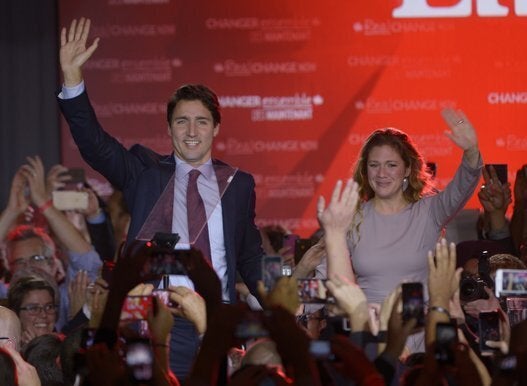OTTAWA — Despite promising to run a surplus in its first year in government, the NDP will most likely run a deficit — unless it dips into the employment insurance fund to pad its bottom line.
The NDP released a fiscal plan Wednesday projecting a $4.1-billion surplus in 2016-2017, but several experts told The Huffington Post Canada that number is misleading and wildly unrealistic.
Using the NDP’s numbers and the parliamentary budget officer’s more up-to-date estimates based on a Bank of Canada July forecast for economic growth, the NDP’s bottom line is a $2-billion surplus that includes a $1-billion contingency.
But when the employment insurance balance — $3.5 billion, according to the NDP and the Finance department’s projections — is subtracted, the NDP’s budget for 2016-2017 comes to $1.49 billion deficit.
“The surplus itself includes the surplus in the EI,” NDP Quebec candidate Guy Caron confirmed Thursday.
The NDP isn’t using the EI operating account to balance its books, he said, because its $4.1-billion surplus is larger than the total of the fund. Caron said the Conservatives, and the Liberals before them, had used the EI account to balance their books and the NDP wouldn’t do that.

Thomas Mulcair, seen in Edmonton on Sept. 11, 2015, ruled out dipping into the employment insurance fund.
NDP Leader Thomas Mulcair was asked Wednesday whether he would dip into the fund to pay for announcements or balance his budgets.
“Absolutely not. And that is not part of our thinking. It is not even our way of understanding that because that fund is put in by every employer and every employee,” he told reporters.
The $4.1-billion surplus that the NDP estimates, however, is based on fiscal projections from the Conservatives’ April budget that have been roundly criticized.
Scott Clark, a former deputy minister of finance, told HuffPost the NDP was using the $3.5 billion to get a surplus “just like the Conservatives.”
“Those are exactly the numbers that underline Mulcair’s budget,” he said.
“If you believe that last April’s budget is out of date because oil prices are much lower and economic growth is much lower, then this is all fantasy.”
Clark noted how the NDP projects spending $3.76 billion more than it takes in in its fourth year in government, but maintains it will post a $4-billion surplus based on a “rosy” federal forecast of $7.8 billion — that includes a $3-billion contingency.

The April budget forecast assumes the price of oil at US$67 next year, US$75 after that, and US$78 in each of the following years. A barrel of West Texas Intermediate — the benchmark used for Canadian oil prices — is currently at US$46.90.
Mulcair should be asked on the campaign trail why he thinks oil will be US$80 a barrel, especially when most analysts believe the price will drop in the next few years, Clark said.
“If he’s going to assume an old forecast he has to be able to defend that,” the former top public servant now teaching at the University of Ottawa said. “He’s fudging the books, to say it mildly, [he’s] choosing a forecast that helps him out.”
“The bottom line is it doesn’t balance,” Clark said.
NDP Toronto candidate Andrew Thomson, a former Saskatchewan finance minister, said the party’s math is sound.
“Regardless of whether you use the department of finance numbers, or the parliamentary budget officer number, the NDP plan balances,” he said.
The NDP had used Finance Canada’s forecast for “comparability purposes,” Thomson explained.
“That’s stupid,” responded Liberal Toronto candidate John McCallum, a former chief economist for Royal Bank of Canada.
'The NDP numbers don't add up'
Parties should use the most up-to-date information available, he said. “The Finance department may be the bible on the day the numbers come out, but when months pass circumstances change, and so you don’t base your future forecasts on out-of-date, outmoded foundation.”
“The NDP numbers don’t add up,” McCallum said, “and they’ve shown they are deficit.”
Canadian Labour Congress economist Angella MacEwen told HuffPost NDP staff had walked her through its budget plan — she acted as an external evaluator — and had assured her that even with the PBO’s growth projections, “they were protecting the EI account, and there would still be a surplus.”
MacEwen said the reason the NDP had ensured a $4.1 billion surplus was because they knew the price of oil was $10 lower. “They know that surplus is going to end up being smaller,” she said.
'Swiss-cheese' plan
Former parliamentary budget officer Kevin Page, who has been consulted by Mulcair and the NDP team, said he was disappointed with the party’s thin financial document and use of Conservative finance minister Joe Oliver’s budget as a benchmark.
“Why give Mr. Oliver that kind of credibility?” Page asked. “They are now in a debate and [the NDP] can’t really say that is not a credible forecast. They used it.”
Page and Clark said they were both concerned with the NDP use of the contingency reserve towards its bottom line.
“They could have done better,” Page told HuffPost. The NDP’s plan, he added, has “potential sustainability problems over the medium term” and isn’t very prudent or transparent.
“They’ve exposed [Mulcair] because this is a Swiss-cheese fiscal costing platform,” he said.
NDP spokesman George Soule initially told HuffPost that “over the two years” —using PBO numbers — the party would be “in surplus.”
But hours later he clarified the NDP would “balance the budget in all four years and [would] not raid the EI fund.”

Also on HuffPost
